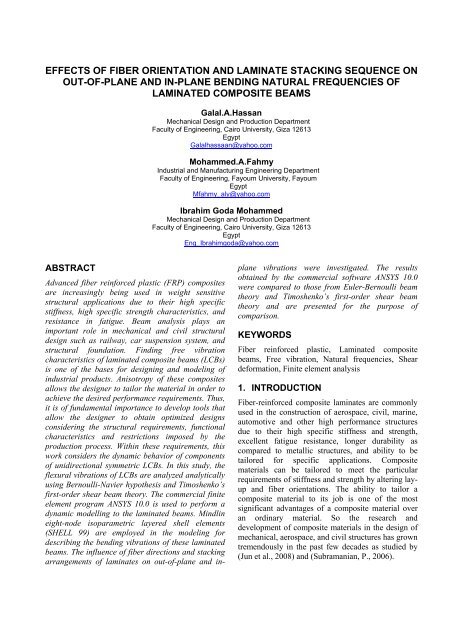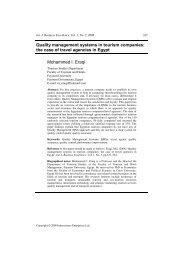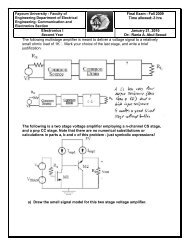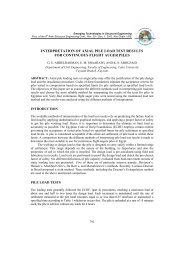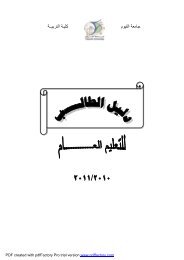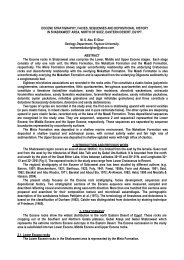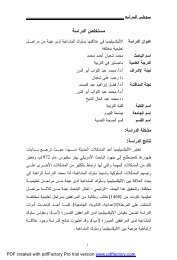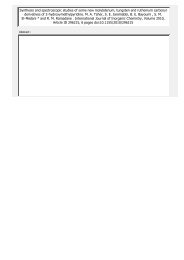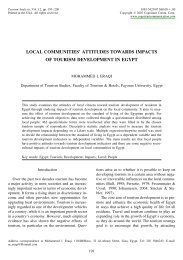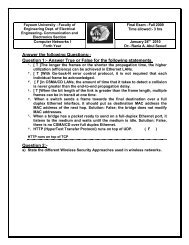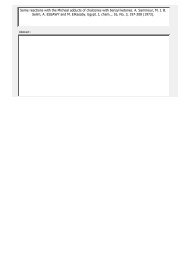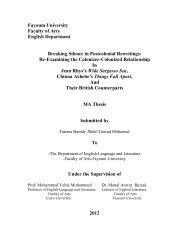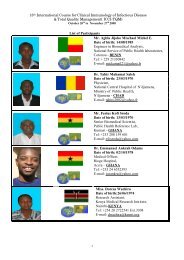EFFECTS OF FIBER ORIENTATION AND LAMINATE STACKING ...
EFFECTS OF FIBER ORIENTATION AND LAMINATE STACKING ...
EFFECTS OF FIBER ORIENTATION AND LAMINATE STACKING ...
Create successful ePaper yourself
Turn your PDF publications into a flip-book with our unique Google optimized e-Paper software.
<strong>EFFECTS</strong> <strong>OF</strong> <strong>FIBER</strong> <strong>ORIENTATION</strong> <strong>AND</strong> <strong>LAMINATE</strong> <strong>STACKING</strong> SEQUENCE ON<br />
OUT-<strong>OF</strong>-PLANE <strong>AND</strong> IN-PLANE BENDING NATURAL FREQUENCIES <strong>OF</strong><br />
<strong>LAMINATE</strong>D COMPOSITE BEAMS<br />
ABSTRACT<br />
Advanced fiber reinforced plastic (FRP) composites<br />
are increasingly being used in weight sensitive<br />
structural applications due to their high specific<br />
stiffness, high specific strength characteristics, and<br />
resistance in fatigue. Beam analysis plays an<br />
important role in mechanical and civil structural<br />
design such as railway, car suspension system, and<br />
structural foundation. Finding free vibration<br />
characteristics of laminated composite beams (LCBs)<br />
is one of the bases for designing and modeling of<br />
industrial products. Anisotropy of these composites<br />
allows the designer to tailor the material in order to<br />
achieve the desired performance requirements. Thus,<br />
it is of fundamental importance to develop tools that<br />
allow the designer to obtain optimized designs<br />
considering the structural requirements, functional<br />
characteristics and restrictions imposed by the<br />
production process. Within these requirements, this<br />
work considers the dynamic behavior of components<br />
of unidirectional symmetric LCBs. In this study, the<br />
flexural vibrations of LCBs are analyzed analytically<br />
using Bernoulli-Navier hypothesis and Timoshenko’s<br />
first-order shear beam theory. The commercial finite<br />
element program ANSYS 10.0 is used to perform a<br />
dynamic modelling to the laminated beams. Mindlin<br />
eight-node isoparametric layered shell elements<br />
(SHELL 99) are employed in the modeling for<br />
describing the bending vibrations of these laminated<br />
beams. The influence of fiber directions and stacking<br />
arrangements of laminates on out-of-plane and in-<br />
Galal.A.Hassan<br />
Mechanical Design and Production Department<br />
Faculty of Engineering, Cairo University, Giza 12613<br />
Egypt<br />
Galalhassaan@yahoo.com<br />
Mohammed.A.Fahmy<br />
Industrial and Manufacturing Engineering Department<br />
Faculty of Engineering, Fayoum University, Fayoum<br />
Egypt<br />
Mfahmy_aly@yahoo.com<br />
Ibrahim Goda Mohammed<br />
Mechanical Design and Production Department<br />
Faculty of Engineering, Cairo University, Giza 12613<br />
Egypt<br />
Eng_Ibrahimgoda@yahoo.com<br />
plane vibrations were investigated. The results<br />
obtained by the commercial software ANSYS 10.0<br />
were compared to those from Euler-Bernoulli beam<br />
theory and Timoshenko’s first-order shear beam<br />
theory and are presented for the purpose of<br />
comparison.<br />
KEYWORDS<br />
Fiber reinforced plastic, Laminated composite<br />
beams, Free vibration, Natural frequencies, Shear<br />
deformation, Finite element analysis<br />
1. INTRODUCTION<br />
Fiber-reinforced composite laminates are commonly<br />
used in the construction of aerospace, civil, marine,<br />
automotive and other high performance structures<br />
due to their high specific stiffness and strength,<br />
excellent fatigue resistance, longer durability as<br />
compared to metallic structures, and ability to be<br />
tailored for specific applications. Composite<br />
materials can be tailored to meet the particular<br />
requirements of stiffness and strength by altering layup<br />
and fiber orientations. The ability to tailor a<br />
composite material to its job is one of the most<br />
significant advantages of a composite material over<br />
an ordinary material. So the research and<br />
development of composite materials in the design of<br />
mechanical, aerospace, and civil structures has grown<br />
tremendously in the past few decades as studied by<br />
(Jun et al., 2008) and (Subramanian, P., 2006).
It is essential to know the vibration characteristics of<br />
these structures, which may be subjected to dynamic<br />
loads in complex environmental conditions. If the<br />
frequency of the loads variation matches one of the<br />
resonance frequencies of the structure, large<br />
translation/torsion deflections and internal stresses<br />
can occur, which may lead to failure of structure<br />
components. In order to achieve the right<br />
combination of material properties and service<br />
performance, the dynamic behavior is one of the<br />
main points to be considered. To avoid the typical<br />
problems caused by vibrations, it is important to<br />
determine: a) the natural frequencies of the structure<br />
and b) the modal shapes to reinforce the most<br />
flexible regions or to locate the right positions where<br />
weight should be reduced or damping should be<br />
increased. With respect to these dynamic aspects, the<br />
composite materials represent an excellent possibility<br />
to design components with requirements of dynamic<br />
behavior as mentioned by (Tita et al., 2003). A<br />
variety of structural components made of composite<br />
materials such as turbine blades, vehicle axles,<br />
aircraft wing, and helicopter blade can be<br />
approximated as laminated composite beams, which<br />
requires a deeper understanding of the vibration<br />
characteristics of the composite beams as mentioned<br />
by (Kapuria and Alam, 2006).<br />
Due to the composite beams widely used in a variety<br />
of structures as well as their substantial benefits and<br />
great promise for future application, the dynamic<br />
behaviors of the laminated composite beams have<br />
received widespread attention and have been<br />
investigated extensively by many researchers. A<br />
number of researchers have been developed<br />
numerous solution methods to analysis the dynamic<br />
behaviors of the laminated composite beams (Khdeir<br />
and Reddy, 1994), (Krishnaswamy et al., 1992), and<br />
(Matsunaga, H., 2001).<br />
The classical laminated beam theory, developed by<br />
Euler-Bernoulli, is used only for thin beams because<br />
this theory has neglected both transverse shear and<br />
normal strains and it is inaccurate for a moderately<br />
deep laminated beam with relatively soft transverse<br />
shear modulus and for highly anisotropic composites.<br />
The inaccuracy is due to neglecting the transverse<br />
shear and normal strains in the laminate. In order to<br />
take into account the effects of low ratio of<br />
transverse shear modulus to the in-plane modulus,<br />
the first order shear deformation theory of<br />
Timoshenko has been developed (Matsunaga, H.,<br />
2001). However, since in the theory the transverse<br />
shear strain is assumed to be constant in the depth<br />
direction, a shear correction factor has to be<br />
incorporated to adjust the transverse shear stiffness<br />
for studying the dynamic problems of beams<br />
(Matsunaga, H., 2001). The accuracy of solutions of<br />
the first order shear deformation theory will be<br />
strongly dependent on predicting better estimates for<br />
the shear correction factor (Matsunaga, H., 2001).<br />
Theoretical analyses of flexural vibration of layered<br />
beams have been studied by several researchers.<br />
Miller and Adams (1975) have been studied the<br />
vibration characteristics of orthotropic clamped-free<br />
beams without including the effect of the shear<br />
deformation. Bhimaraddi and Chandrashekhara<br />
(1991) considered the modeling of laminated beams<br />
by a systematic reduction of the constitutive relations<br />
of the three-dimensional anisotropic body and<br />
concluded that these relations should be adopted<br />
while modeling especially angle-ply laminated<br />
composite beams. Matsunaga, H. (2001) analyzed<br />
natural frequencies and buckling stresses of general<br />
cross-ply laminated composite beams by taking into<br />
account the complete effects of transverse shear and<br />
normal stresses and rotary inertia. Abramovich, H.<br />
(1992) gave exact solutions, based on the<br />
Timoshenko type equations, for symmetrically<br />
laminated composite beams with 10 different<br />
boundary conditions. The rotary inertia and shear<br />
deformation effects were investigated for simply<br />
supported beams with h/b=1 for the axial and out-of<br />
plane bending vibration cases (Abramovich, H.,<br />
1992). Zapfe and Lesieutre (1997) presented an<br />
iterative smeared model for the vibration analysis of<br />
laminated beams. Jun, L. et al. (2008) investigated<br />
the free vibration and buckling behaviors of axially<br />
loaded laminated composite beams having arbitrary<br />
lay-up using the dynamic stiffness method. Qiao<br />
Pizhong and Zou Guiping (2002) presented an<br />
analytical study for dynamic behavior of pultruded<br />
fiber-reinforced plastic (FRP) composite cantilever Ibeams<br />
based on a Vlasov-type linear hypothesis.<br />
A significant amount of research has been conducted<br />
on the vibration analysis of laminated beams with<br />
focusing on classical lamination theory, Timoshenko<br />
first order beam theory, and higher order beam<br />
theory. Abramovich and Livshits (1994) studied the<br />
free vibration of non symmetric Cross-ply laminated<br />
Composite Beams based on Timoshenko type<br />
equations. The effect of coupled longitudinal and<br />
transversal displacements, shear deformation and<br />
rotary inertia are included in the analysis<br />
(Abramovich and Livshits, 1994). Eisenberger, M. et
al. (1995) used the dynamic stiffness analysis and the<br />
first-order shear deformation theory to study the free<br />
vibration of laminated beams. Vinson and<br />
Sierakowski (2004) obtained the exact solution of a<br />
simply supported composite beam based on the<br />
classical theory, which neglects the effects of the<br />
rotary inertia and shearing deformation. Khdeir and<br />
Reddy (1994) have been studied free vibrations of<br />
cross-ply laminated beams with arbitrary boundary<br />
conditions. Krishnaswamy, S. et al. (1992) gave<br />
analytical solutions for the free vibration problem of<br />
laminated composite beams. Also, Dynamic<br />
equations governing the free vibration of laminated<br />
composite beams are developed using Hamilton's<br />
principle; the effects of transverse shear and rotary<br />
inertia are included in the energy formulation<br />
(Krishnaswamy, S. et al., 1992). Song and Waas<br />
(1997) have been studied both buckling and free<br />
vibration analyses of laminated composite beams.<br />
They Song and Waas (1997) also investigated the<br />
shear deformation effects. Yildirim, V. (2000) used<br />
the stiffness method for the solution of the purely inplane<br />
free vibration problem of symmetric cross-ply<br />
laminated beams with the rotary inertia, axial and<br />
transverse shear deformation effects included by the<br />
first-order shear deformation theory. Banerjee, J.<br />
(1998) has investigated the free vibration of axially<br />
laminated composite Timoshenko beams using<br />
dynamic stiffness matrix method. Yõldõrõm and<br />
Kõral (2000) studied the out-of-plane free vibration<br />
problem of symmetric cross-ply laminated beams<br />
using the transfer matrix method. Also, the effects of<br />
the rotary inertia and shear deformation are<br />
investigated under various boundary conditions.<br />
Kant, T. et al. (1998) developed an analytical<br />
solution to the dynamic analysis of the laminated<br />
composite beams using a higher order refined theory.<br />
This model also fails to satisfy the traction- free<br />
surface conditions at the top and bottom surfaces of<br />
the beam but has included the effect of transverse<br />
normal strain. Rao et al. (2001) proposed a higherorder<br />
mixed theory for determining the natural<br />
frequencies of a diversity of laminated Simply-<br />
Supported beams. Also they Rao et al. (2001)<br />
developed an analytical method for evaluating the<br />
natural frequencies of laminated composite and<br />
sandwich beams using higher-order mixed theory and<br />
analyzed various beams of thin and thick sections.<br />
Many authors have given finite element solutions to<br />
analysis the dynamic of laminated beams. Bassiouni<br />
et al. (1999) presented a finite element model to<br />
investigate the natural frequencies and mode shapes<br />
of the laminated composite beams. The model<br />
required all lamina had the same lateral displacement<br />
at a typical cross-section, but allowed each lamina to<br />
rotate a different amount from the other. The<br />
transverse shear deformation was included. Tahani,<br />
M. (2007) developed a new layerwise beam theory<br />
for generally laminated composite beam and<br />
compared the analytical solutions for static bending<br />
and free vibration with the three-dimensional<br />
elasticity solution of cross-ply laminates in<br />
cylindrical bending and with three-dimensional finite<br />
element analysis for angle-ply laminates.<br />
Chandrashekhara and Bangera (1992) investigated<br />
the free vibration of angle-ply composite beams by a<br />
higher-order shear deformation theory using the<br />
shear flexible FEM. Maiti and Sinha (1994)<br />
developed a finite element method (FEM) to analyze<br />
the vibration behavior of laminated composite beams<br />
and investigated the effects of various parameters.<br />
Murthy et al. (2005) derived a refined 2-node beam<br />
element based on higher order shear deformation<br />
theory for axial-flexural-shear coupled deformation<br />
in asymmetrically stacked laminated composite<br />
beams. Ramtekkar et al. (2002) developed a six-node<br />
plane-stress mixed finite element model by using<br />
Hamilton’s principle. Natural frequencies of crossply<br />
laminated beams were obtained and various<br />
mode shapes were presented. Teh and Huang (1979)<br />
presented two finite element models based on a firstorder<br />
theory for the free vibration analysis of fixedfree<br />
beams of general orthotropy. Nabi and Ganesan<br />
(1994) examined bi-axial bending, axial and torsional<br />
vibrations using the finite element method and the<br />
first-order shear deformation theory. Harmonic<br />
response of tapered composite beams was examined<br />
using the finite element analysis based on the higher<br />
order shear deformation theory by (Rao and Ganesan,<br />
1997). Suresh and Malhotra (1998) studied the<br />
vibration and damping behaviour of layered<br />
composite box beams using the finite element<br />
method and the finite element formulation is based<br />
on first order shear deformation theory which takes<br />
shear deformation of the beam into consideration.<br />
Aydogdu, M. (2005) studied the vibration of crossply<br />
laminated beams subjected to different sets of<br />
boundary conditions. The analysis is based on a<br />
three-degree-of-freedomshear deformable beam<br />
theory. Jun et al. (2008) presented a dynamic finite<br />
element method for free vibration analysis of<br />
generally laminated composite beams on the basis of<br />
first order shear deformation theory. Subramanian, P.<br />
(2006) has investigated free vibration analysis of<br />
LCBs by using two higher order displacement based
on shear deformation theories and finite elements.<br />
Both theories assume a quintic and quartic variation<br />
of in-plane and transverse displacements in the<br />
thickness coordinates of the beam respectively.<br />
Results indicate application of these theories and<br />
finite element model results in natural frequencies<br />
with higher accuracy.<br />
Most of the previous works are focused on the study<br />
of dynamic behavior of laminated composite beams,<br />
especially the out of plane bending vibration<br />
(flexural vibration). In the present study, the effects<br />
of fiber angle and laminate stacking sequence on the<br />
out-of-plane and in-plane bending frequencies for the<br />
laminated beams are investigated separately. In this<br />
study the laminated beams is modeled and analyzed<br />
by the FEM. The finite element software package<br />
ANSYS is used to perform the numerical analyses<br />
using an eight-node layered shell element. The rotary<br />
inertia and shear deformation effects are taken into<br />
account. Also, in the present work, an analytical<br />
study for dynamic behavior of laminated beams is<br />
presented; where the out-of-plane and in-plane<br />
bending vibrations of LCBs are analyzed analytically<br />
using Bernoulli-Nervier hypothesis and Timoshenko<br />
beam analysis.<br />
2. MATERIALS <strong>AND</strong> MECHANICAL<br />
PROPERTIES<br />
A generally laminated composite beam, as shown in<br />
Figure 1, is considered. The laminated beam is made<br />
of many plies of orthotropic materials, and the<br />
principal material axes of a ply may be oriented at an<br />
arbitrary angle with respect to the x-axis. In the righthanded<br />
Cartesian coordinate system, the x-axis is<br />
coincident with the beam axis and its origin is on the<br />
mid-plane of the beam. The length, breadth and<br />
thickness of the beam are represented by L, b and h,<br />
respectively.<br />
Figure 1 Geometry of a laminated composite beam<br />
2.1. Materials characterization<br />
Glass fiber (E-Glass) is used as reinforcement in the<br />
form of unidirectional fibers with epoxy resin as matrix<br />
for the laminated composite beams. The mechanical<br />
properties for fiber and matrix are presented in Table 1<br />
(Danial et al., 2003). For all finite element and<br />
analytical models, their associate material elastic<br />
properties were calculated analytically using the simple<br />
rule-of-mixtures as given in (Vinson and Sierakowski,<br />
2004). More accurate values can be further obtained<br />
with some mechanical testing.<br />
The constituent laminae were considered to be linear<br />
elastic and generally orthotropic therefore the concept<br />
of engineering constants was used to describe the<br />
laminae elastically. A certain set of elastic properties is<br />
required as input parameters for the finite element code<br />
and for the analytical model. The set of properties<br />
required as an input parameter at a material level were<br />
E1, E2, E3, G12, G13, G23, v12, v13 and v23 as shown in<br />
Table 1; Where 1, 2, and 3 are principal material<br />
directions.<br />
Table 1 Material elastic properties<br />
Material Properties<br />
Fiber longitudinal modulus in ℓ<br />
direction Efℓ (GPa)<br />
Value<br />
74<br />
Glass fiber<br />
Fiber transverse modulus in t<br />
direction Eft (GPa)<br />
Fiber shear modulus Gfℓt (Gpa)<br />
74<br />
30<br />
Epoxy resin<br />
Laminae<br />
(orthotropic)<br />
Density ρf (kg/m 3 ) 2600<br />
Fiber Poisson ratio νfℓt<br />
0.25<br />
Elastic modulus E (Gpa) 4.5<br />
Shear modulus G (Gpa) 1.6<br />
Density ρm (kg/m3) 1200<br />
Poisson ratio ν 0.4<br />
Lamina longitudinal modulus E1<br />
(GPa)<br />
46.2<br />
Lamina transverse modulus E2<br />
(GPa)<br />
14.70<br />
Lamina transverse modulus E3<br />
(GPa)<br />
14.70<br />
Density of composite ρc (kg/m3) 2040<br />
Lamina shear modulus in plane<br />
1–2 G12 (GPa)<br />
Lamina shear modulus in plane<br />
1–3 G13 (GPa)<br />
Lamina shear modulus in plane<br />
2–3 G23 (GPa)<br />
Major Poisson ratio in plane<br />
1–2 υ12<br />
Major Poisson ratio in plane<br />
1–3 υ13<br />
Major Poisson ratio in plane<br />
2–3 υ23<br />
5.35<br />
5.35<br />
5.22<br />
0.31<br />
0.31<br />
0.41<br />
Fiber volume fraction vf 60%
3. DYNAMIC MODELING BY THE FINITE<br />
ELEMENT METHOD, ANSYS<br />
3.1. Element type<br />
The beams were discretized using (type shell99)<br />
finite element Figure 2, available in the commercial<br />
package ANSYS10.0. This element has 8 nodes and<br />
is constituted by layers that are designated by<br />
numbers (LN - Layer Number), increasing from the<br />
bottom to the top of the laminate; the last number<br />
quantifies the existent total number of layers in the<br />
laminate (NL - Total Number of Layers).The element<br />
has six degrees of freedom at each node: translations<br />
in the nodal x, y, and z directions and rotations about<br />
the nodal x, y, and z-axes. The choice of shell99<br />
element type is based on layered applications of a<br />
structural shell model, and the type of results that<br />
need to be calculated.<br />
xIJ = Element x-axis if ESYS is not supplied.<br />
x = Element x-axis if ESYS is supplied.<br />
Figure 2 Shell99 geometry<br />
3.2. Analysis type<br />
Modal analysis will be carried out with ANSYS 10.0<br />
finite element software. A modal analysis typically is<br />
used to determine the vibration characteristics<br />
(natural frequencies and mode shapes) of a structure<br />
or machine component in the design stage. It can also<br />
serve as a starting point for another, more detailed,<br />
dynamic analysis, such as a transient dynamic<br />
analysis, a harmonic response analysis, or a spectrum<br />
analysis.<br />
4. DYNAMIC MODELING BY<br />
ANALYTICAL METHODS<br />
In the present paper, the out-of-plane and in-plane<br />
bending free vibration of symmetric laminated beams<br />
are studied by the Bernoulli-Euler and Timoshenko’s<br />
first-order shear beam theories.<br />
4.1. Bernoulli-Navier hypothesis<br />
The oldest and the well-known beam theory is the<br />
Euler–Bernoulli beam theory (or classical beam<br />
theory—CBT) which assumed that straight lines<br />
perpendicular to the mid-plane before bending<br />
remain straight and perpendicular to the mid-plane<br />
after bending. As a result of this assumption,<br />
transverse shear strain is neglected. Although this<br />
theory is useful for slender beams, it does not give<br />
accurate solutions for thick beams.<br />
The beams to be analyzed are orthotropic and its<br />
cross section has two axes of symmetry y and z. The<br />
mass is also symmetrical with respect to these axes,<br />
and, accordingly, the center of mass coincides with<br />
the origin of the y-z coordinate system. A beam with<br />
two cross-sectional planes of symmetry may undergo<br />
flexural vibration in either of the two planes of<br />
symmetry and torsional vibration (La'szlo' and<br />
George, 2003). Flexural vibrations are focused in this<br />
study.<br />
The natural frequencies of orthotropic beams are:<br />
Vibration in x-z plane is given by,<br />
μ<br />
2π<br />
* ρ L<br />
4<br />
B 2 EI yy Bi<br />
ω ) = (1)<br />
yi<br />
4<br />
(<br />
Vibration in x-y plane is given by<br />
μ<br />
2π<br />
* ρ L<br />
4<br />
B 2 EI zz Bi<br />
ω ) = (2)<br />
zi<br />
4<br />
(<br />
Where:<br />
EI yy is the bending stiffness about y axis; in N.m 2 ,<br />
EI zz is the bending stiffness about z axis; in N.m 2 ,<br />
L is the length of the beam, ρ is the mass per unit<br />
length, and µ 4 Bi for fixed-free beam are given in<br />
Table 2 .The subscript i = 1,2,.. indicates the first,<br />
second, and so forth, modes.<br />
For symmetric orthotropic laminated beam;<br />
The bending stiffness about y axis EI yy can be<br />
obtained by this relation<br />
EI yy =<br />
b in (N.m<br />
d11<br />
2 ) (3)
The bending stiffness about z axis EI zz can be<br />
obtained by this relation<br />
EI zz =<br />
Where:<br />
3<br />
1 b<br />
in (N.m<br />
a 12<br />
2 ) (4)<br />
11<br />
d11: element 1–1 of the laminate bending compliance<br />
matrix (1/N .m)<br />
a11: element 1–1 of the laminate extensional<br />
compliance matrix (m/N)<br />
Table 2 The constants μBi and μGi for fixed free end<br />
support<br />
μB<br />
μB1 = 1.875<br />
μB2 = 4.694<br />
μBi ≈ (i-0.5)<br />
μG<br />
μGi ≈ (i-0.5)π<br />
4.2. Timoshenko’s first-order shear<br />
beam theory<br />
The theory, based on the assumption that cross<br />
sections remain plane but not perpendicular to the<br />
axis is frequently called first-order shear theory. A<br />
beam, in which shear deformation is taken into<br />
account, is called a Timoshenko beam.<br />
Timoshenko beam theory was developed to account<br />
for shear deformation with the assumption that the<br />
displacement field through the beam thickness does<br />
not restrict plane sections to remain perpendicular to<br />
the deformed centroidal line. However, the theory<br />
still imposes planar normals to the centroidal line to<br />
remain planar after deformation. The constant shear<br />
strain distribution throughout the beam thickness<br />
violates the shear traction free condition on the top<br />
and bottom surfaces of the beam. Shear correction<br />
factors are then employed to correct the discrepancy<br />
between results derived from exact solutions and<br />
solutions obtained via shear deformation theory.<br />
The natural frequencies of the orthotropic beams<br />
with shear deformation are:<br />
Vibration in x-z plane is given by, ωyi<br />
(<br />
yi<br />
)<br />
⎡<br />
1<br />
1<br />
)<br />
2<br />
≈ ⎢ + B 2 S<br />
( ω yi ) ( ω yi<br />
ω (5)<br />
⎣<br />
2<br />
⎤<br />
⎥<br />
⎦<br />
−1<br />
μ<br />
2π<br />
* ρ L<br />
2<br />
S 2 S ZZ Si<br />
ω ) = (6)<br />
yi<br />
2<br />
(<br />
Vibration in x-y plane is given by, ωZi<br />
2 ⎡ 1 1 ⎤<br />
( ω Zi ) ≈ ⎢ + 2 S 2<br />
( ) ( )<br />
⎥<br />
(7)<br />
B<br />
⎣ ωZi<br />
ωZi<br />
⎦<br />
2<br />
S S 2<br />
yy μSi<br />
ω ) = (8)<br />
Zi<br />
2<br />
(<br />
2π<br />
* ρ L<br />
Where ω B is the natural frequency of a beam<br />
undergoing bending deformation only, ω S is the<br />
natural frequency of a beam undergoing shear<br />
deformation only, Szz is the shear stiffness in x-z<br />
plane; in N, Syy is the shear stiffness in x-y plane; in<br />
N, and µSi = µGi for fixed-free beam is given in Table<br />
2.<br />
The shear stiffness in Z direction (Transverse shear<br />
stiffness) is given by, Szz<br />
/ 2 5<br />
= ∫ 55<br />
6<br />
h<br />
S b Q dz<br />
(9)<br />
ZZ<br />
−h<br />
/ 2<br />
2<br />
2<br />
Q = G cos ϑ + G sin ϑ<br />
(10)<br />
55 13<br />
23<br />
Q<br />
Where 55 is the transformed shear stiffness and ϑ<br />
is the angle between the fiber direction and<br />
longitudinal axis of the beam.<br />
The shear stiffness in y direction (Lateral shear<br />
stiffness) is given by, Syy<br />
b<br />
S yy = (11)<br />
1. 2a<br />
66<br />
Where a66 is element 6–6 of the laminate extensional<br />
compliance matrix (m/N)<br />
−1<br />
5. NUMERICAL RESULTS <strong>AND</strong><br />
DISCUSSION<br />
5.1. Influence of fiber angle on out of<br />
plane bending frequencies<br />
The influences of fiber orientation are investigated<br />
by modeling laminated beams of different lay-up<br />
construction of fixed – free boundary condition. The<br />
evaluation of the dynamic behavior was performed<br />
on beams with different lay-up with the same length,<br />
width, and thickness. The analysis was performed to<br />
8-layered symmetrically laminated beam with length
400 mm, width 40 mm and thickness 3.2 mm and the<br />
lamination scheme of beams is ranging from θ= 0 0 to<br />
90 0 , in increments of 5 0 .<br />
The following results are obtained after modeling the<br />
composite beams by FE ANSYS, Euler–Bernoulli<br />
theory, and Timoshenko beam theory. The variations<br />
of the lowest six out-of-plane bending frequencies of<br />
the laminated beams with respect to fiber angle are<br />
presented in Figures 3 and 4. From the results, it is<br />
noticed that out-of plane bending frequencies<br />
decreases, in general, as the fiber angle increases; in<br />
Natural frequency (Hz)<br />
300<br />
250<br />
200<br />
150<br />
100<br />
50<br />
0<br />
0 10 20 30 40 50 60 70 80 90<br />
Fiber orientation (θ)<br />
the case of the effect of fiber orientation, it is found<br />
that the maximum out-of-plane bending vibration<br />
frequencies occur at θ = 0 0 .<br />
5.2. Influence of fiber angle on in plane<br />
bending frequencies<br />
The influences of fiber orientation on natural<br />
frequencies of plane x-y vibration modes are<br />
investigated for the laminated beams previously<br />
mentioned, and the results are plotted in Figure 5.<br />
FEM---1st Mode<br />
Euler-Bernoull---1st Mode<br />
Timoshenko---1st Mode<br />
FEM---2nd Mode<br />
Euler-Bernoull---2nd Mode<br />
Timoshenko---2nd Mode<br />
FEM---3rd Mode<br />
Euler-Bernoulli---3rd Mode<br />
Timoshenko---3rd Mode<br />
Figure 4 Variation of the out-of-plane bending frequencies of 1st, 2nd, and 3rd mode with respect to fiber<br />
angle for fixed-free boundary condition<br />
Natural frequency (Hz)<br />
1400<br />
1200<br />
1000<br />
800<br />
600<br />
400<br />
200<br />
0<br />
0 10 20 30 40 50 60 70 80 90<br />
Fiber orientation (θ)<br />
FEM---4th Mode<br />
Euler-Bernoull---4th Mode<br />
Timoshenko---4th Mode<br />
FEM---5th Mode<br />
Euler-Bernoull---5th Mode<br />
Timoshenko---5th Mode<br />
FEM---6th Mode<br />
Euler-Bernoulli---6th Mode<br />
Timoshenko---6th Mode<br />
Figure 5 Variation of the out-of-plane bending frequencies of 4 th , 5 th , and 6 th mode with respect to fiber angle<br />
for fixed-free boundary condition.
The variation of the lowest three in-plane bending<br />
frequencies of the laminated beams with respect to<br />
fiber angle is presented in Figure 5. From the results,<br />
it was found that the in-plane bending frequencies<br />
decrease gradually with increasing fiber angle up to<br />
70 0 then it increases by small values or nearly<br />
constant until it reaches to 90 0 .<br />
5.3. Influence of laminate stacking<br />
sequences on out-of-plane and in-<br />
plane natural frequencies<br />
The influences of laminate stacking sequences on<br />
natural frequencies of out of plane bending and in<br />
plane bending modes are investigated by FE ANSYS,<br />
Euler–Bernoulli theory, and Timoshenko beam<br />
theory; by modeling laminated beams of different<br />
Natural frequency (Hz)<br />
3500<br />
3000<br />
2500<br />
2000<br />
1500<br />
1000<br />
500<br />
0<br />
0 10 20 30 40 50 60 70 80 90<br />
Fiber orientation (θ)<br />
stacking sequences configuration of fixed – free<br />
boundary condition.<br />
The dynamic modeling of the laminated beams is<br />
performed to 3 set of symmetrical laminates with a<br />
total of 8 layers and dimension of 400 mm length, 40<br />
mm width and total thickness 3.2 mm. Assume each<br />
layer has the same thickness. The lamination<br />
schemes of the laminated beams to be modeled are as<br />
follow: (0/90)2S, (45/-45)2S, and (45/-45/0/90)S.<br />
The numerical results obtained are tabulated in<br />
Tables 3 and 4.<br />
The mode shapes associated with the frequencies of<br />
(0/90)2S laminated beam are illustrated in Figures 6<br />
and 7 They are deduced by FEM ANSYS for the first<br />
six out of plane bending frequencies and for the first<br />
three in plane bending frequencies.<br />
FEM---1st Mode<br />
Euler-Bernoull---1st Mode<br />
Timoshenko---1st Mode<br />
FEM---2nd Mode<br />
Euler-Bernoull---2nd Mode<br />
Timoshenko---2nd Mode<br />
FEM---3rd Mode<br />
Euler-Bernoulli---3rd Mode<br />
Timoshenko---3rd Mode<br />
Figure 6 Variation of the lowest three in-plane bending frequencies with respect to fiber angle for fixed-free<br />
boundary condition<br />
Table 3 The first six out of plane bending natural frequencies (Hz) for different stacking sequence laminates<br />
Lamination<br />
schemes<br />
Theory Modes<br />
1 2 3 4 5 6<br />
(0/90)2S FEM ANSYS 13.71 85.85 240.14 470.00 775.67 1156.00<br />
Euler–Bernoulli 13.70 85.80 240.30 470.70 778.1 1162.40<br />
Timoshenko 13.70 85.70 240.00 469.50 774.7 1155.00<br />
(45/-45)2S FEM ANSYS 9.38 58.78 165.20 325.90 542.94 817.42<br />
Euler–Bernoulli 9.15 57.32 160.54 314.50 520.00 776.70<br />
Timoshenko 9.15 57.30 160.40 314.15 518.85 774.36
(45/-45/0/90)s FEM ANSYS 10.27 64.30 180.45 355.20 590.20 886.24<br />
Euler–Bernoulli 10.06 63.07 176.70 346.00 572.00 854.60<br />
Timoshenko 10.06 63.05 176.53 345.60 570.70 851.56<br />
Table 4 The first three in plane bending natural frequencies (Hz) for different stacking sequence laminates<br />
Z<br />
Y<br />
Z<br />
Z<br />
X<br />
Y<br />
X<br />
X<br />
Lamination<br />
schemes<br />
Theory Modes<br />
1 2 3<br />
(0/90)2S FEM ANSYS 154.4 893.0 2256.0<br />
Euler–Bernoulli 156.5 980.8 2747.0<br />
Timoshenko 154.3 924.6 2361.3<br />
(45/-45)2S FEM ANSYS 114.9 701.4 1890.0<br />
Euler–Bernoulli 115.0 720.5 2018.0<br />
Timoshenko 114.6 711.0 1945.0<br />
(45/-45/0/90)s FEM ANSYS 139.5 836.2 2202.0<br />
Euler–Bernoulli 140.2 879.0 2462.0<br />
Timoshenko 139.3 854.7 2283.5<br />
1 st Mode - 13.71 Hz<br />
3 rd Mode - 240.14 Hz<br />
5 th Mode - 775.67 Hz<br />
Z<br />
84<br />
Z<br />
Z<br />
Y<br />
Y<br />
Y<br />
X<br />
X<br />
X<br />
2 nd Mode - 85.85 Hz<br />
4 th Mode - 470 Hz<br />
6 th Mode - 1156 Hz<br />
Figure 7 The first six out of plane bending vibration modes of fixed-free beam
Z<br />
Y<br />
X<br />
1 st Mode - 154.4 Hz<br />
Z<br />
Y<br />
X<br />
Z<br />
Y<br />
X<br />
3 rd Mode - 2256 Hz<br />
2 nd Mode - 893 Hz<br />
Figure 8 The first three in plane bending vibration modes of fixed-free beam<br />
The results presented in Figure 8 are obtained by FE<br />
package after modeling the three laminate<br />
configurations. It represents the variations of the outof-plane<br />
bending frequencies with respect to mode<br />
number of the 3 laminate schemes for fixed free<br />
boundary conditions. From the results, it is already<br />
possible to verify the influence of the stacking<br />
sequence of the laminates on out-plane frequencies;<br />
the laminate with fibers at +/-45 o has in general<br />
smaller natural frequencies than the laminate with +/-<br />
45/0/90 o layers and than the laminate with fibers at 0 o<br />
and 90 o .<br />
The laminate with fibers at 0 o and 90 o has a larger<br />
natural frequency for out of plane bending (Flexural<br />
Modes) than the laminate of +/-45/0/90 o and than the<br />
(+/-45 o ) laminate. Because 50% of the fibers are<br />
oriented at 0 0 direction for 0/90 0 laminate, and thus<br />
appropriate for bending (Flexural Modes). This can<br />
be explained by the fact that the fibers oriented at 0°<br />
are more appropriate to flexural loads.<br />
The variation of the in-plane bending frequencies of<br />
the 3 laminate schemes with respect to mode number<br />
for fixed free boundary conditions is presented in<br />
Figure 9. From the results it is already possible to<br />
verify the influence of the stacking sequence of the<br />
laminates on in-plane bending frequencies (Lateral<br />
modes). The laminate with fibers at 0/90 0 has in<br />
general larger natural frequencies than the laminate<br />
with +/-45/0/90 0 layers and than the laminate with<br />
fibers at +/-45 0 . This is because 50% of the fibers are<br />
oriented at 0 0 for 0/90 0 laminate.<br />
Natural frequency (Hz)<br />
1400<br />
1200<br />
1000<br />
800<br />
600<br />
400<br />
200<br />
0<br />
(0/90)2s Laminate (45/-45/0/90)s Laminate<br />
(45/-45)2s Laminate<br />
1 2 3 4 5 6<br />
Mode no<br />
Figure 9 Influence of laminate stacking sequence on<br />
natural frequencies of out of plane vibration<br />
modes for fixed free boundary condition
Natural frequency (Hz)<br />
2500<br />
2000<br />
1500<br />
1000<br />
500<br />
0<br />
(0/90)2s Laminate (45/-45/0/90)s Laminate<br />
(45/-45)2s Laminate<br />
1 2<br />
Mode no<br />
3<br />
Figure 10 Influence of laminate stacking<br />
sequence on natural frequencies of in-plane<br />
vibration modes for fixed free boundary<br />
condition.<br />
6. CONCLUSION<br />
From the results, it is clear that changes in fiber<br />
angle as well as laminate stacking sequences yield to<br />
different dynamic behavior of the component, that is,<br />
different natural frequencies for the same geometry,<br />
mass and boundary conditions. This gives the<br />
designer one additional degree of freedom to design<br />
the laminate - the possibility to change fiber<br />
orientations in order to get more (or less) structure<br />
stiffness. This possibility makes once more these<br />
materials very attractive since it makes possible to<br />
obtain the desired natural frequencies without<br />
increasing mass or changing geometry. In practical<br />
applications, it means that if a natural frequency<br />
excites the structure, the designer can change the<br />
material properties by changing the laminate<br />
stacking sequence, instead of re-design the complete<br />
structure.<br />
Also from the results, it has found that the out-of<br />
plane and in-plane bending frequencies decrease, in<br />
general, as the fiber angle increases and the<br />
maximum out-of-plane and in-plane bending<br />
vibration frequencies occur at θ = 0 0 .<br />
The theoretical results from Finite Element Analysis,<br />
ANSYS showed in general a good agreement with<br />
the numerical results values obtained by Bernoulli<br />
hypothesis and Timoshenko beam theory. This<br />
agreement is clearly shown for the out-of-plane<br />
lower modes than the higher modes.<br />
The finite element software package ANSYS is an<br />
efficient vibration prediction tool, because of its<br />
ability to model the laminated composite beam and<br />
reveal fundamental modal frequencies and modal<br />
shapes. (By using of shell element SHELL99), it is<br />
useful for simpleness (saving of computing time).<br />
Finally this study is useful for the designer in order<br />
to select the fiber orientation angle to shift the<br />
natural frequencies as desired or to control the<br />
vibration level.<br />
REFERENCES<br />
Abramovich A, Livshits A., (1994), "Free vibration of<br />
non-symmetric cross-ply laminated composite beams",<br />
Journal of Sound and Vibration, Vol. 38, pp. 597-612.<br />
Abramovich H., (1992), "Shear deformations and rotary<br />
inertia effects of vibrating composite beams",<br />
Composite Structures, Vol. 20, pp. 165-73.<br />
Aydogdu M., (2005), "Vibration analysis of cross-ply<br />
laminated beams with general boundary conditions by<br />
Ritz method", International Journal of Mechanical<br />
Sciences, Vol.47, pp. 1740–1755.<br />
Banerjee, J.R., (1998), "Free vibration of axially loaded<br />
composite timoshenko beams using the dynamic<br />
stiffness matrix method", Computers and Structures,<br />
Vol. 69, pp. 197-208.<br />
Bassiouni AS, Gad-Elrab RM, Elmahdy TH., (1999),<br />
"Dynamic analysis for laminated composite beams",<br />
Composite Structures, Vol. 44 pp. 81–87.<br />
Bhimaraddi A., Chandrashekhara K., (1991), "Some<br />
observations on the modeling of laminated composite<br />
beams with general lay-ups", Composite Structures,<br />
Vol. 19, pp. 371-380.<br />
Chandrashekhara K., Bangera K.M., (1992), "Free<br />
vibration of composite beams using a refined shear<br />
flexible beam element", Computer and Structures, Vol.<br />
43, pp. 719-727.<br />
Danial Gay, Hoa SV, Tsai SW., (2003), Composite<br />
materials design and applications, Boca Raton, London<br />
New York, Washington.<br />
Eisenberger M, Abramovich H, Shulepov O., (1995),<br />
"Dynamic stiffness analysis of laminated beams using<br />
a first-order shear deformation theory", Composite<br />
Structure, Vol.31, pp. 265-271.<br />
Jun L, Hongxing H, Rongying S., (2008), "Dynamic finite<br />
element method for generally laminated composite<br />
beams", International Journal of Mechanical Sciences,<br />
Vol. 50, pp. 466–480.<br />
Jun L, Hongxing H, Rongying S., (2008), "Dynamic<br />
stiffness analysis for free vibrations of axially loaded
laminated composite beams", Composite Structures,<br />
Vol. 84, pp. 87–98.<br />
Kant T, Marurb SR, Rao GS., (1998), "Analytical solution<br />
to the dynamic analysis of laminated beams using<br />
higher order refined theory", Composite Structures,<br />
Vol.40, pp. 1–9.<br />
Kapuria S, Alam N., (2006), "Efficient layerwise finite<br />
element model for dynamic analysis of laminated<br />
piezoelectric beams", Computer Methods in Applied<br />
Mechanics and engineering, Vol. 195, pp. 2742–2760.<br />
Khdeir A.A., Reddy J.N., (1994), "Free vibration of crossply<br />
laminated beams with arbitrary boundary<br />
conditions", International Journal of Engineering<br />
Science, Vol. 32, pp.1971-1980.<br />
Krishnaswamy S., Chandrashekhara K., Wu W.Z.B.,<br />
(1992), "Analytical solutions to vibration of generally<br />
layered composite beams"., Journal of Sound and<br />
Vibration, Vol. 159, pp. 85-99.<br />
La'szlo' P., George S., (2003), Mechanics of composite<br />
structures, Cambridge University, New York, United<br />
States of America.<br />
Maiti D.K., Sinha P.K., (1994), “Bending and free<br />
vibration analysis of shear deformable laminated<br />
composite beams by finite element method”,<br />
Composite Structures, Vol.29, pp. 421-431.<br />
Matsunaga H., (2001), "Vibration and buckling of<br />
multilayered composite beams according to higher<br />
order deformation theories", Journal of Sound and<br />
Vibration, Vol. 246, pp.47-62.<br />
Miller AK, Adams DF., (1975), "An analytic means of<br />
determining the flexural and torsional resonant<br />
frequencies of generally orthotropic beams", Journal of<br />
Sound and Vibration, Vol. 41, pp. 433-449.<br />
Murthy M.V.V.S., Mahapatra D.R., Badarinarayana K.,<br />
Gopalakrishnan S., (2005) "A refined higher order<br />
finite element for asymmetric composite beams",<br />
Composite Structures, Vol.67, pp. 27-35.<br />
Nabi MS, Ganesan N., (1994), "Generalized element for<br />
the free vibration analysis of composite beams",<br />
Computer and Structures, Vol.51, pp. 607-610.<br />
Qiao Pizhong, Zou Guiping., (2002), "Free vibration<br />
analysis of fiber-reinforced plastic composite<br />
cantilever I-beams", Mechanics of Advanced Materials<br />
and Structure, Vol. 9, pp. 359–373.<br />
Ramtekkar G.S., Desai Y.M., Shah A.H., (2002), "Natural<br />
vibrations of laminated composite beams by using<br />
mixed finite element modeling", Journal of Sound and<br />
Vibration, Vol.257, pp. 635-651.<br />
Rao MK, Desai YM, Chitnis MR., (2001), "Free<br />
vibrations of laminated beams using mixed<br />
theory",Composite Structures, Vol. 52, pp. 149–60.<br />
Rao SM, Ganesan N., (1997), "Dynamic response of nonuniform<br />
composite beams", Journal of Sound and<br />
Vibration, Vol. 200, pp. 563-77.<br />
Song SJ, Waas A., (1997), "Effects of shear deformation<br />
on buckling and free vibration of laminated composite<br />
beams", Composite Structures, Vol.37, pp.33-43.<br />
Subramanian, P., (2006), "Dynamic analysis of laminated<br />
composite beams using higher order theories and finite<br />
elements", Composite Structures, Vol. 73, pp. 342-<br />
353.<br />
Suresh KJ, Venkatesan C, Ramamurti V., (1990),<br />
"Structural dynamic analysis of composite beams",<br />
Journal of Sound and Vibration, Vol.143, pp. 503-519.<br />
Suresh R, Malhotra SK.,(1998), "Vibration and damping<br />
analysis of thin-walled box beams", Journal of Sound<br />
and Vibration, Vol. 215, pp. 201-210.<br />
Tahani M., (2007) "Analysis of laminated composite<br />
beams using layerwise displacement theories",<br />
Composite Structures, Vol.79, pp.535–47.<br />
Teh KK, Huang CC., (1979), "The vibration of generally<br />
orthotropic beams-A finite element approach", Journal<br />
of Sound and Vibration, Vol.62, pp.195-206.<br />
Tita V, Carvalho J, Lirani J., (2003), "Theoretical and<br />
experimental dynamic analysis of fiber reinforced<br />
composite beams", Journal of the Brazilian Society of<br />
Mechanical Sciences and Engineering, Vol. 25, pp.<br />
306-310.<br />
Vinson JR, Sierakowski RL., (2004), The behaviour of<br />
structures composed of composite materials, New<br />
York, Boston, Dordrecht, Moscow.<br />
Yildirim V., (2000), "Effect of the longitudinal to<br />
transverse moduli ratio on the in-plane natural<br />
frequencies of symmetric cross-ply laminated beams<br />
by the stiffness method" Composite Structures, Vol.50,<br />
pp. 319–26.<br />
Yõldõrõm V, Kõral E., (2000), "Investigation of the rotary<br />
inertia and shear deformation effects on the out-ofplane<br />
bending and torsional natural frequencies of<br />
laminated beams", Composite Structures,Vol.49, pp.<br />
313-320.<br />
Zapfe JA, Lesieutre GA., (1997) "Vibration analysis of<br />
laminated beams using an iterative smeared laminated<br />
model", Journal of Sound and Vibration, Vol. 199, pp.<br />
275-84.


